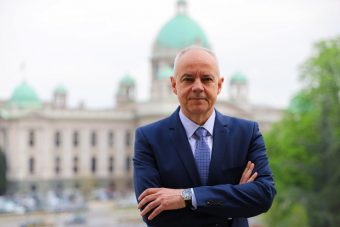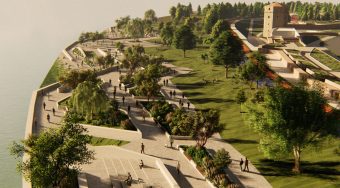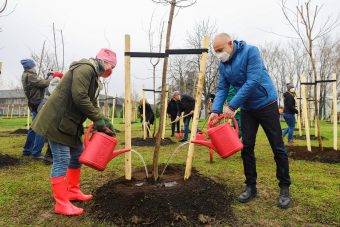
The development of rail transport, purchase of electric buses and trams, construction of water waste treatment facility, thermal rehabilitation of buildings, introduction of public bicycle system, bicycle trails expansion, building 10,000 m² of green walls and a 10 percent increase of wood areas, those are some of the essential plans which need an investment of 5,2 billion euros so that Belgrade could reach European standards of the Green City in 10 years. We asked the Mayor of Belgrade, Prof. Zoran Radojičić, Ph.D., about this and other plans and activities of Belgrade, which will bring the Serbian capital in line with the goals of the Western Balkans Green Agenda.
EP: The countries in the region, Serbia included, have signed the Western Balkans Green Agenda, therefore took an obligation to introduce measures to prevent climate change and pollution, clean energy development, and circular economy. Has Belgrade made the strategy for Green City development, and what are its priorities?
Zoran Radojičić: The Belgrade City Assembly has adopted, in the last session, a few critical strategic documents and action plans which deal with the very same questions. First, I would mention The Action Plan for Green City, which we have prepared with the support of The European Bank for Reconstruction and Development and the Government of Japan. The main goal of this plan is air quality enhancement. To achieve that, we have set four priority sectors that contribute to air quality enhancement. Those are introducing renewable energy sources and energy efficiency, wastewater and waste treatment, urban planning, mobility, greening, and climate change. In addition, this plan has laid down the projects for the development of rail transport, purchase of electric buses and trams, construction of water waste treatment facility, thermal rehabilitation of the buildings, the introduction of public bicycle system, expansion of cycle lanes network, construction of 10,000 m² green walls and enlargement of areas covered by woods by 10 percent in Belgrade. According to the estimation, we need an investment of 5,2 billion EUR over ten years so that Belgrade could reach European standards for Green City.

EP: In proportion to some researches, more than half of Belgradians think the biggest problem of their capital is air pollution. Have you established what mostly pollutes the air in Belgrade and how to resolve this problem long-term? Have we set a goal, for example, for how much we should reduce greenhouse gas emissions by 2030?
Zoran Radojičić: We have also adopted The 2030 Air Quality Plan, with Short-term and Long-term Action Plans. According to the experts’ analysis, the traffic throughout the year is the constant source of pollution. During the winter, the biggest polluters are individual furnaces, which amount to around 200,000 pcs. The Short-term Action Plan implies the response to increased air pollution. That means we will intensify public transport in the city to prompt citizens not to use their cars and we will regulate traffic thoroughly to prevent bottlenecks and traffic jams. The Long-term measures refer mainly to completing the Belgrade ring road that will enable us to eliminate the transit transport from the heart of the capital. Next, there is the construction of the subway system, development of rail transport, transition to electric and gas buses, and expansion of cycle lanes. Furthermore, we take seriously investments in energy efficiency in buildings, privately or publicly owned, as much as the completion of the program for the shutting down of incinerators and connection to the district heating system and gas line, and the additional greening of the city. The question of greenhouse gas emission reduction is of high importance, particularly in combating climate change. Upon signing the Global Covenant of Mayors for Climate and Energy in 2018, we have committed to reducing greenhouse gas emissions by 40 percent and making an action plan for sustainable climate and energy. This plan is rather ambitious but can turn our vision of Belgrade as a green and sustainable city into reality by making a joint effort to implement this plan.
In focus:
EP: Belgrade is the only European capital that releases wastewater into the Danube. In contrast, the third of the capital’s population isn’t connected to the sewage system. Instead, it is bound to use septic tanks whose contents are discharged directly into the rivers. What project under The Green Agenda framework could help remediate the dire state of rivers, and what has The City of Belgrade done concerning this matter so far?

Zoran Radojičić: The City of Belgrade, unfortunately, hasn’t come to the ultimate solution for the sewage and wastewater treatment system. Still, the great news is that we work continuously on solving this decades-old problem. The project preparation is underway, and the construction of the Veliko selo wastewater facility is expected to start in the fall. This facility will collect wastewater from the old Belgrade’s central part, southern (Sremčica, Železnik, Banovo brdo), and western part (Novi Beograd, Zemun). The project will be implemented in two stages, and the facility will be stretched across around 97 ha. The first stage includes the construction of the missing infrastructure, the new sewage pumping station Ušće-Nova, and the reconstruction of the Mostar pumping station. In the second stage, the wastewater treatment is based on a primary and secondary treatment to separate sludge in primary tanks. In contrast, nitrogen and phosphorus will be eliminated in advanced procedures based on activated charcoal. The investment value for the Veliko selo wastewater treatment facility is 271 million EUR. This project is implemented in cooperation with the Ministry of construction, transport and infrastructure, and the China Machinery Engineering Corporation. Upon the facility construction, almost 80 percent of communal wastewater will be treated before discharge into rivers. The remaining 20 percent of wastewater will be treated in the wastewater facilities in Ostružnica, Batajnica, and Grocka, whose construction has been funded by the City of Belgrade. As for the building of the missing sewage infrastructure, which the EIB credit line has financed, the project implementation in underway for the sewage construction on the Danube left bank, in the settlements of Borča, Ovča, Kotež, and Krnjača.
EP: Circular economy is one of the European Green Deal goals. The most crucial instrument of the circular economy is recycling. Belgrade doesn’t have enough recycling garbage cans to start with, so our citizens could fully adopt this behavior model, let alone a sufficient number of cans to completely use this type of waste as a resource. What are the fundamental bases for the development of a circular economy in our capital?
Zoran Radojičić: For a circular economy to be adopted, it is necessary to establish an efficient system of primary waste separation, which is determined as a priority goal by the new Local waste management plan 2021-2030 envisaged. The new plan entails placing green islands and underground garbage cans to collect recyclable waste in the city center. The containers for collecting separated waste will be positioned in other parts of the city. At the moment, there are around 730 underground garbage bins for recyclables separation, and it is planned to get additional 300 bins by the end of the year. Across the city parts with individual housing, there are garbage cans for primary waste separation used by around 27,000 households, and this year we will give away additional 25,000 garbage cans. There is a plan to build another seven recycling centers and four transfer stations where the waste will be delivered before being sent to further treatment. The goal is to take only recyclable waste to the Vinča landfill. Also, we want to increase the household recycling rate to 25 percent by the end of 2025 and 35 percent by 2030. One of the goals until 2028 is to reduce the quantity of biodegradable waste disposed to 75 percent compared to the amount from 2008. Also, we want to completely harmonize goals for collecting and recycling packaging waste by 2028 following the EU Packaging and Packaging Waste Directive.
Prepared by: Nevena Đukić
Read the story in the new issue of the Energy portal Magazine WATER RESOURCES.



